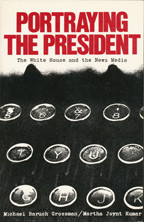The media have become principal actors on the American political scene. Politicians and their press secretaries release news items with one eye on the event and the other on the millions of voters who depend on the White House press corps to keep them informed about the workings of their government.
Portraying the President explores the inner workings of the relationship between the White House and the press. Rather than emphasize the well-publicized sparring between inquisitive reporters and evasive administrative spokesmen intent on enhancing the President's public image, the authors stress...
The media have become principal actors on the American political scene. Politicians and their press secretaries release news items with one eye on the event and the other on the millions of voters who depend on the White House press corps to keep them informed about the workings of their government.
Portraying the President explores the inner workings of the relationship between the White House and the press. Rather than emphasize the well-publicized sparring between inquisitive reporters and evasive administrative spokesmen intent on enhancing the President's public image, the authors stress the vast amount of cooperation between journalists and their sources. They point out the similarities of the White House-media relationship in recent administrations and suggest what shape it is likely to take in the future.
The authors also address the key issues of information management and manipulation by both the administration and the press. Grossman and Kumar demonstrate that, whether a lower level staff member leaks a news item to elevate his own status or an official spokesman mentions a new policy proposal in order to gather support, the release of information to the White House press corps involves complicated strategies among a number of administrative personnel. Washington reporters, aware of some of these tactics, compensate by cultivating personal sources and trading information with officials. Nevertheless, the routine nature of White House reporting and the competitiveness of modern news organizations often trap the reporter into what has been called "pack journalism."
Interviews with current and former White House reporters, including Bob Schieffer, Tom Brokaw, James Naughton, James Reston, and John Osborne, give Portraying the President an authentic, firsthand sound and feel. Comments from Ron Nessen, Gerald Rafshoon, Jody Powell, and other presidential spokesmen and advisors, give insight into White House operations during the Nixon, Ford, and Carter administrations.
Portraying the President provides information vital to an appreciation of the modern American political system. Its thought-provoking conclusions will be of interest political scientists, media specialists, and anyone interested in current affairs.






